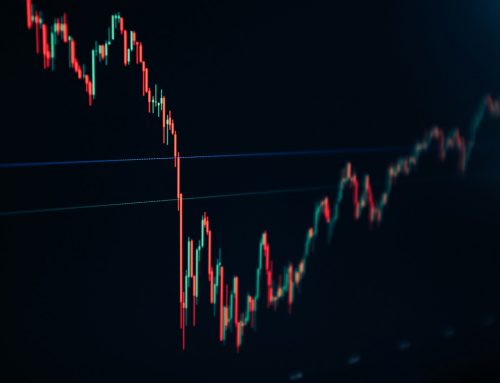There’s a battle raging on Wall Street. The Bulls are looking for a market bottom and the Bears are saying the selling will continue. Both camps are making their point with a plethora of facts, fiction and fluff. How can we cut through the flack and focus on what’s really going to happen?
Three Powerful Forces Driving the Market
Astute investors know three powerful forces drive the stock market. These forces are known to everyone, but are often misunderstood. They are related, but independent. They are measurable, but controversial. They convey the affects of all that happens, and ultimately determine the fate of the market.
1. Corporate Earnings
When a major event such as an assassination, earthquake, or international financial crisis occurs, investors instinctively speculate on whether the event will help or hurt the stocks they own. If the event seems likely to help corporate earnings, prices rise. Conversely, if the news is perceived to be harmful, prices fall.
2. Inflation
The bug-a-boo of a strong economy is inflation. Inflation, of course, causes raw material, labor and service costs to increase. Unless a company increases productivity and raises prices, profit margins narrow and earnings go down.
Rising inflation rates ultimately push stock prices down. It not only lessens the value of financial assets, it erodes the purchasing power of consumers. Left unchecked, inflation destroys monetary stability and leads to a weak economy.
3. Interest Rates
The Federal Reserve is charged with the responsibility of maintaining monetary stability. It fulfills this task by controlling the money supply. When the Fed sees inflation increasing, it tightens the money supply and interest rates go up.
Ironically, higher interest rates raise costs. It stifles investment, weakens the economy, hurts corporate earnings and eventually leads to a Bear market.
Interest rates are perhaps the most powerful force driving the stock market.
In summary, prices rise when earnings go up. Prices fall when inflation rises and when interest rates increase.
So how does the individual investor take advantage of this knowledge? You could spend hours pouring over the financials in the Wall Street Journal. Then spend additional hours deciphering the quarterly reports of companies you find promising…or you could simply check VectorVest.
How VectorVest Works
The first step in picking stocks is to favor stocks of companies that are making money—lots of money. Study stocks of companies with rapidly growing earnings and choose stocks of companies which consistently make more money than they did the year before.
The question of price arises even if you do the above. Profitable, high-growth stocks usually sell at very high prices. How high of a price is too high? The only way to answer this question is to know what a stock is really worth.
VectorVest calculates the Value of every stock every day and provides this information in a simple, concise format. With a mouse click you can identify undervalued stocks. Apple, Inc. (AAPL), for example, has a current Value of $611.20 as of this writing (1/3/2012). It is undervalued compared to its Price of $411.23 per share. Value is calculated using forecasted earnings per share, forecasted earnings growth, profitability, interest and inflation rates.
That’s not the end of the story with Value, however. VectorVest also calculates a proprietary indicator called Relative Value.
What a stock is really worth— Relative Value
With VectorVest’s Relative Value, those stocks with the greatest price appreciation potential are identified. Apple, Inc. (AAPL) is currently undervalued but what about its Value next month or even next year? VectorVest provides a second measure of Value called Relative Value (RV).
Relative Value is an indicator of long-term price appreciation potential. It answers the question, should you invest in AAPL or instead put your money in a safe, benchmark investment like a Triple A Corporate Bond?
Relative Value (RV) is on a scale from 0.00 to 2.00. If the RV is above 1.00, an investment in AAPL should outperform the AAA bond. As of this writing, AAPL has a Relative Value of 1.60, which is excellent.
Undervalued stocks offer a higher probability of achieving gains, the potential for very large gains and lower downside risk. In other words, undervalued stocks increase the odds of winning, increase the rewards for winning, and decrease the risk of losing compared to overvalued stocks.
How safe it is—Relative Safety
Have you ever noticed that the prices of stocks like McDonald’s (MCD) and Church & Dwight Company, Inc. (CHD) never seem to cause any excitement, yet go up year after year? Stocks like Toll Brothers, Inc. are always in the news, and go up and down like a yo-yo.
There’s a very simple reason for this contrast. The former have track records of steady earnings performance while the latter has an erratic earnings record. Price volatility is a reflection of fear and uncertainty.
Price volatility and risk arise from many sources—rumors, political assassinations, earthquakes and so on. Shareholders with little confidence in their company tend to overreact to rumors and bad news. Consequently, the stock prices of companies with erratic earnings performance suffer more when unfortunate things happen. Stocks of companies with steady, predictable earnings can weather nearly any storm.
Obviously, there’s less risk in holding stocks of financially stable companies. Therefore, analyze the risk factors of stocks very carefully before buying.
The second key factor in picking stocks is to favor safe stocks. VectorVest calculates another proprietary indicator called Relative Safety (RS). Also on a scale from 0.00 to 2.00, pick stocks in the VectorVest system with Relative Safety values above 1.00—and well above 1.00 if you are conservative.
Relative Safety identifies how safe a stock is relative to all stocks. With a mouse click, VectorVest instantly identifies how much risk you would assume in buying any stock. The stock with the highest safety rating as of this writing is Fastenal Co. (FAST), with an RS rating of 1.50, which is excellent.
To determine RS, VectorVest looks at the consistency and predictability of a company’s financial performance, debt to equity ratio, sales volume, business longevity, price volatility and other factors.
Imagine the time it would take to accurately put this data together yourself. We have done all the work for you. VectorVest favors the purchase of stocks of companies with consistent, predictable financial performance.
How strong is the Price Momentum—Relative Timing
Investors would love to know exactly when to get in a trade and when to get out. Conventional wisdom teaches us to buy stocks on the way down. However, the stocks that are most likely to go up in price are those that are already going up.
A stock that is hitting new highs has essentially no overhead resistance. There are no unhappy buyers waiting to get their money back. Stocks hitting their very first 52-WEEK high are very attractive. These stocks have had plenty of time to consolidate and are showing new signs of life.
VectorVest identifies the direction of a stock’s price movement with a momentum indicator called Relative Timing. Relative Timing (RT) signals a stock’s short-term price performance. On a scale from 0.00 to 2.00, a stock is in an uptrend when its RT is above 1.00. When the RT is below 1.00, the stock’s price is in a downtrend. When the price trend flattens out, the RT returns to 1.00.
Relative Timing analyzes the direction of a stock’s price movements, the magnitude of its price changes, and the dynamics of these changes. These factors determine whether or not a stock’s price will rise or fall and how strong that price momentum will be. Buying stocks with rising prices does not preclude the idea of buying them right after they hit bottom. Bottom Fishing is a great sport. You just have to know when the price trend has gone from down to up.
VectorVest makes it easy to pick stocks with rising prices—just select stocks with a Relative Timing number above 1.00. One of the highest rated Relative Timing stocks as of this writing is Cobalt International Energy (CIE) with an RT rating of 1.86, which is excellent. RT is a very intelligent indicator, and it’s the most important indicator to watch once you have purchased a stock.
VST-Vector—The Investor’s Edge
VectorVest’s stock analysis and graphics software analyzes over 23,000 stocks worldwide every day for Value, Safety and Timing. It unifies these factors into a comprehensive indicator called VST-Vector.
Stocks with the highest VST-Vector ratings have the best combinations of Value, Safety and Timing and are the safe, undervalued stocks we have been talking about. The stock with the highest VST rating as of this writing is Apple (AAPL), with a VST rating of 1.50, which is excellent.
There’s no need to spend hours and hours doing what a computer can do. You can obtain a complete rank analysis of any list of stocks with VectorVest in just a few seconds. Our records show that stocks with the highest VST-Vector ratings outperform the market over the long-term.
When to Buy, Sell and Hold
Every day, VectorVest provides a Buy, Sell or Hold recommendation on every stock. Apple (AAPL) currently has a Buy recommendation which is very difficult for a stock to receive. Four criteria must be met: 1.The Stock Price must be above its Stop Price. 2.The Fundamentals must be favorable. 3.The Price Momentum must be favorable. 4.The Price must be moving away or diverging from the Stop Price.
*VectorVest calculates a Stop Price on every stock every day. It is based on a 13-week moving average, adjusted for fundamentals. If a stock has very good fundamentals, we lower the Stop Price to keep you in that stock longer. If a company has very poor fundamentals, we will tighten the Stop Price to get you out quicker.
When these criteria are met, VectorVest gives a Buy recommendation for that stock. VectorVest recommends that investors buy safe, undervalued, rising stocks in rising markets. The next step is to identify rising markets.
Market Timing—The Trend is Your Friend
Let’s begin with a clear distinction between Market Timing and Market Forecasting. Forecasting deals with the unknown. As no one has a crystal ball, eventual catastrophic error is certain. The landscape is full of forecasters who have erred—their stories are well documented.
On March 9, 2009, VectorVest nailed the most powerful rally in 70 years, alerting aggressive customers of an explosive rebound. On March 26, 2009, VectorVest recommended Prudent Investors should transition from bottom fishing to top VST stocks, signaling a Confirmed Market Up Call.
Market Timing deals with reading our indicators and letting them tell you when the market is rising or falling, and following the trend. It’s about identifying turning points and knowing when to invest aggressively and when to take defensive actions.
VectorVest’s Market Timing System uses two key indicators. First, we calculate a composite for all U.S. stocks. It’s simply an average price of all the stocks in the database. This is the VectorVest Composite (VVC). Its price movement represents the broader market.
Every day VectorVest analyzes the movements of the VVC price, its momentum and the ratio of Buy to Sell recommendations in our database. These three factors are combined into a master indicator used to identify the market’s underlying trend—the Market Timing Indicator (MTI), and cast onto a scale between 0.00 and 2.00.
The VectorVest Market-Timing System involves two simple rules: 1.If the Price of the VVC moves in a given direction for two weeks, it gives a preliminary signal of a sustainable trend in that direction, and 2.An upturn is confirmed when the Buy/Sell ratio (BSR) goes above 1.00, and a downturn is confirmed when the BSR goes below 1.00.
On June 11, 2008, this system generated a Confirmed Down Market Call just prior to a vicious Bear market sell-off. Had you gone to cash with this market call, you would have avoided one of the worst periods in market history, avoiding losses of over 43% through the following market bottom on November 20, 2008.
I’ve made it easy for you to try VectorVest!
I’m confident you’ll find VectorVest to be the best moneymaking investing tool you’ll ever experience. I want you to try it—the full, complete version— absolutely RISK FREE for 5 weeks—for only $9.95.
No other online service gives you so many options, so much flexibility, so much insight, coverage, online help and analysis.
But don’t take my word for it—see for yourself how powerful VectorVest truly is!
Sincerely,
Bart A. DiLiddo, PhD
Creator, Founder and Chairman of VectorVest, Inc.






Good day! Dear Mr. Bart A. Diliddo! My name is Alex, I’m a newbie, I live in Russia, in a small town in the south of Eastern Siberia. I am very interested in your product Vector Vest, but unfortunately have to admit that it is not possible for me to buy the product because of the absence of the Russian version of the product and adapting it to the world in addition to local market conditions and courses or training programs work. Do not you see you the opportunity to enter the Eastern European market with your product? I think this product will be in great demand in Russia because of its relevance, especially in times of crisis. Sincerely, Alexey Demin.
I wrote a letter to Google translator so sorry for some semantic mismatch. I hope for your understanding.
I watch CNBC all the time and saw your commercial for Vector Vest. It is a great commercial and got me to your website. But when I got to your website it really did not inform me too much more about your product on your home page. There is a lot of empty space on your home page, and after 4 minutes on your site, I get sent to an under construction page. This could be preventing sales!
I own a web design and search engine marketing company and strongly feel that a new web site would increase your conversions from the advertisements. I would be more than happy to set up a call to go more in depth how we can help you increase your conversions, obtain email address to do an email marketing campaign, and increase overall sales!
I would like to speak to the director of marketing or Dr. Bart Diliddo. Please forward this to the appropriate inbox so that I can get a response.
agree with above you need an easier interface fir interested parties
Just curious, Laurel. What would you like to see? Any suggestions on your part will help us with updates and redesigns.
I am member and have both vectorvest us and vectorvest 7 both were removed from my computer. I was able to retrieve Vectorvest us but unable to retrirve Vectorvest 7. Please advise
I attended webinars on: Options Professor and Welcome to Vector Vest. The introductory offers for the
Free or $ 9.99 5 Week Trial were different. What are the varoius options for the 30 day or 5 Day
Trial? Also, the Welcome to Vector Vest webinar included a CD set. Is this different from the
one listed on Web Site under $ 9.99 Trial?
Have been vector vest member for last 4-5 years
I wanted to join Yahoo vector vest group, tried twice and got rejected twice.
Why vector vest members get rejected by yahoo group?
what’s the crieteria for acceptance?
I HAVE SUBSCRIBED BUT I CANNOT ABLE TO OPEN THE VV IN IT IS APPEARING IN TOOL BAR /TASK BAR OF VV BUT THIS NOT GETTING OPEN
Ashok,
Please call our toll-free customer support line. They can help with any technical issues. I’m sure it is something simple that they can help you fix in a matter of minutes! Call 1-888-658-7638 M-F 24 hrs/day and Sat 9-5 ET. If you need a list of our international numbers, you can find them here: https://www.vectorvest.com/contactus.aspx
I am a private trader using technical analysis in stock-picking. I am a candidate of CFA Program, used to work in an investment bank boutique on Wall Street. I started this blog targeting to share my thoughts on stock trading as well as some risk management ideas. Should you have any particular stocks you wish me to analyze,
I am a returned temporary subscriber, now with the (5) week trial, and… understand stocks and options. Question…. Need to retry the programs, and… currently more interested in Options. Which, currently, has the best rate of return, in your opinion, if used correctly with VV? …. Cordially, …. JB
what happened to gv?–gone and down with no warning or comment
I used Vectrovest a couple years ago and I want to get back into again. Please advise as to how I can get back into it.
Is stock symbol AGNC still a good buy?
Hi Ralph,
We’re not brokers, so it is against regulations to give stock advice. But you can certainly check the symbol out with VectorVest to see what the recommendation is. If you aren’t a current subscriber, we do offer a $9.95 trial, which is a great deal!
i’Ve signed up for he $9.99 trial but how to I FIND THE STOC
ck in in your type portfolio?
Hello Stanley,
It’s really easy. Go to the Graphs tab. You’ll see tabs running across the top after you launch VectorVest. Click on the Graphs tab and you’ll see a blank white bar. It should be labeled “Stock.” Type in your stock’s symbol and now you have a nice graph of the stock! Don’t know the stock symbol? Just type the name of the company and VectorVest fills it in for you! If you need assistance, call our support line at 1-888-658-7638. They’re open 24-7 and are happy to help!
I want to be one of VectorVest member, with the aim of buying and selling shares.
If you’re serious, then you should sign up for a 5 week trial. It’s a great deal at only $9.95! We also have great, and free, tech support.
How much is an annual subscription to Victor Vest?
I am asking the price of your stock timing advice
What country are you interested in? We have subscriptions available for several different countries. If you have an interest in the US, give our customer support a call at 1-888-658-7638. They are open M-F 24 hrs/day and on Saturdays from 9am-5pm. If you are interested in another country, our customer support numbers are listed on the contact page. You can also find our pricing on the products page.
hello folks
a ways ago i have gotten a few comments from you on some stocks. its been so long that i think your freebie that you gave me is most probably used up.
can you tell me what your admission charges are
thanks
Conrad,
Contact our customer support. They will have your records on file and can help you out. The number is 1-888-658-7638. You can also go to our products page to see pricing.